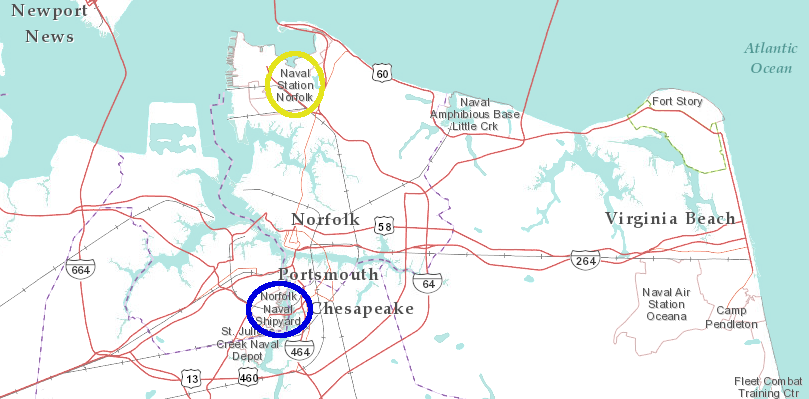
the Norfolk Naval Shipyard is eight miles south of the Norfolk Naval Base ("Naval Station Norfolk")
Source: ESRI, ArcGIS Online

the Norfolk Naval Shipyard is eight miles south of the Norfolk Naval Base ("Naval Station Norfolk")
Source: ESRI, ArcGIS Online

the site of the Norfolk Naval Shipyard on the Elizabeth River was first used by the Gosport Shipyard as far back as 1767
Source: Norfolk Naval Shipyard, Combined Heat and Power Plant and Energy Conservation Measures Briefing (July 1, 2020)
The deep channel of the Elizabeth River, with multiple harbors that were protected from storms, led to the development of Norfolk on the east bank and Portsmouth on the west bank. Despite its name, the Norfolk Naval Shipyard is located within the City of Portsmouth. It has never been located within the boundaries of the City of Norfolk.
The Norfolk Naval Shipyard is located on the west bank of the Southern Branch of the Elizabeth River. It is sometimes confused with Norfolk Naval Base (officially "Naval Station Norfolk"), which was constructed on the east bank opposite Craney Island during World War I for the Atlantic Fleet.
The Norfolk Naval Base is the more-recent military facility. The much-older Norfolk Naval Shipyard is eight miles south of the aircraft carrier base. The shipyard triggered the growth of military facilities in Hampton Roads, including Portsmouth Naval Hospital (built in 1827-30).
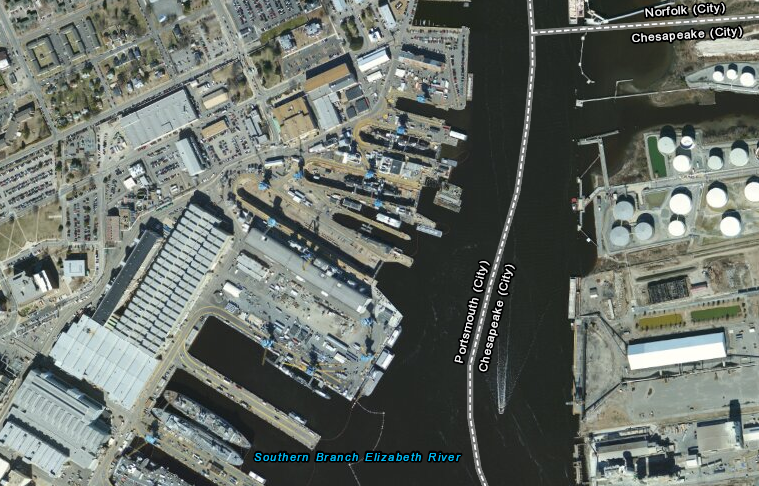
the Norfolk Naval Shipyard is west of the modern City of Chesapeake, incorporated in 1963 to block annexation of Norfolk County land by the City of Norfolk
Source: ESRI, ArcGIS Online
The Norfolk Naval Shipyard was originally called the Gosport Yard. It was started in 1767 as a private facility in 16 acres by a merchant named Andrew Sprowle, who built it next to his home called Gosport. He built it to repair merchant ships and British naval vessels, and to construct new ships with the abundant local timber and naval stores. The shipyard on the Southern Branch of the Elizabeth River was relatively protected from pirates and foreign enemies, and the location was convenient for tobacco exporting ships and others sailing in Hampton Roads.
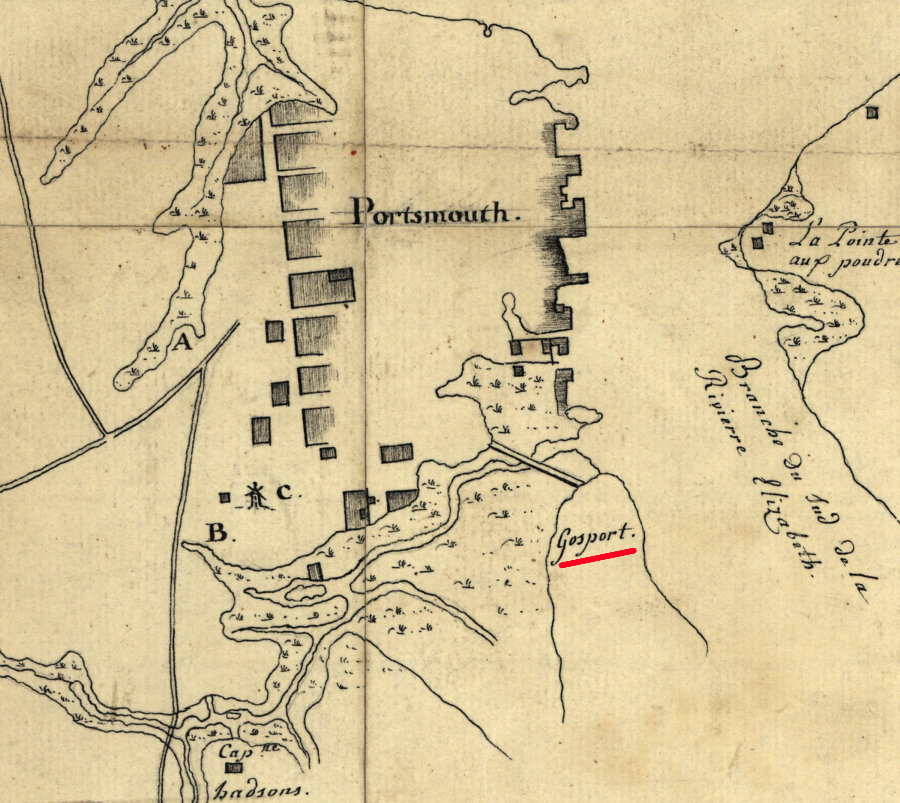
when the French helped defeat the British at Yorktown, Gosport was separated from the developed core of Portsmouth by Crab Creek
Source: Library of Congress, Plan de Portsmouth en Virginie (1781?)
Prior to the Gosport Yard, ship repairs were performed on beaches by "careening" a ship and pulling it over to one side to expose half of the hull at a time. New ships could be constructed on beaches with standard ship carpenter tools; British mariners did not require a dedicated shipyard in order to build a ship. After a hurricane in 1609 wrecked the Sea Venture coming to Jamestown with the Third Supply fleet, the shipwrecked sailors and passengers built the Patience and Deliverance on beaches in Bermuda with a minimal supply of nails and equipment.
It took 160 years from the initial settlement at Jamestown before Sprowle built the first shipyard in the colony. The suitability of land along the Elizabeth River was recognized quickly by English colonists, but until the 1760's Hampton Roads was too exposed to attack.
Prior to British victory in the French and Indian War/Seven Years War in 1763, the Royal Navy lacked clear superiority on the high seas. After the decline of Spain and then the defeat of the French, Britain gained maritime dominance comparable to the global supremacy exerted by the United States after World War II. Once the risk of attack at Hampton Roads was greatly diminished, building a shipyard was a more-realistic investment.
Sprowle named his house and the shipyard after Gosport, England. That town is located in southern England, across the harbor entrance from Portsmouth. "Gosport" is apparently based on the old English name for goose. Sprowle matched the pattern of Portsmouth/Gosport in England. His shipyard was located on the opposite side of Crab Creek from the Virginia town named Portsmouth.
The warehouse at the shipyard was massive, 91 feet long and 41 feet wide. The bottom three stories were constructed with stone, and woiod was used for just the top two stories. Three other warehouses and additional buildings were constructed as well.1
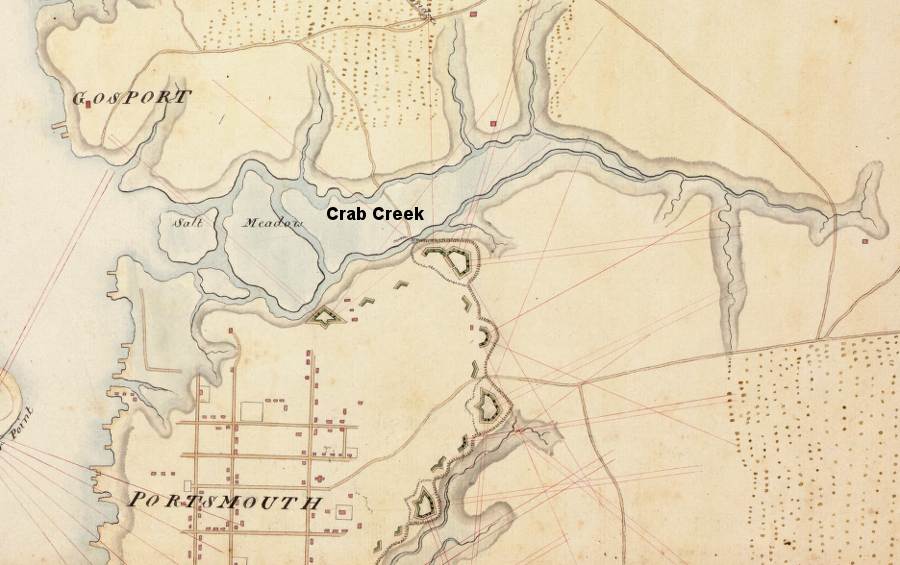
Crab Creek once separated Gosport from Portsmouth
(note map orientation - south is towards top of map, and Crab Creek flows from west-to-east to the salt meadow at the confluence with the Southern Branch of the Elizabeth River)
Source: Library of Congress, A plan of Portsmouth Harbour in the province of Virginia shewing the works erected by the British forces for its defence, 1781
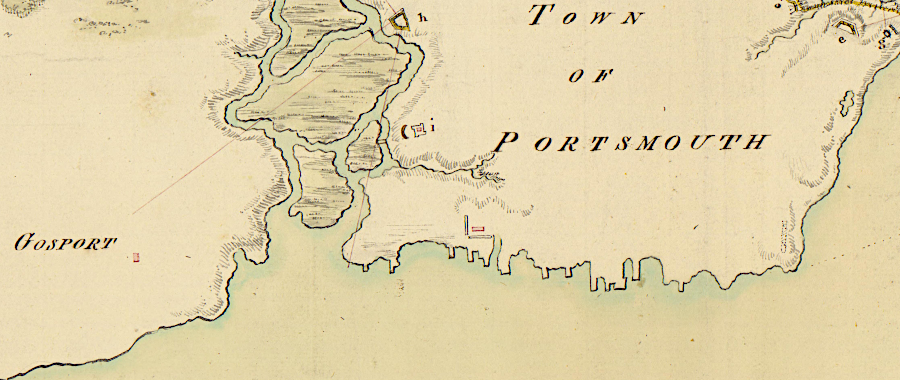
the shipyard was built in Gosport, with Crab Creek separating it from Portsmouth
Source: University of Michigan, William L. Clements Library, Plan of the post of Portsmouth as it is occupied by his majesty's forces under the command of Major General Phillips, April 1st, 1781
Modern visitors to the Virginia version of Portsmouth/Gosport will have difficulty finding the creek that divided the two places in 1767. Crab Creek now lies buried under the modern I-264 highway, which crosses Portsmouth before going under the Elizabeth River via the Downtown Tunnel (built in 1952) near the NTelos Pavilion. South Street, just north of the interstate, marks the old southern edge of Portsmouth, and modern-day Columbia Street just to the north was originally Crabbe Street.2
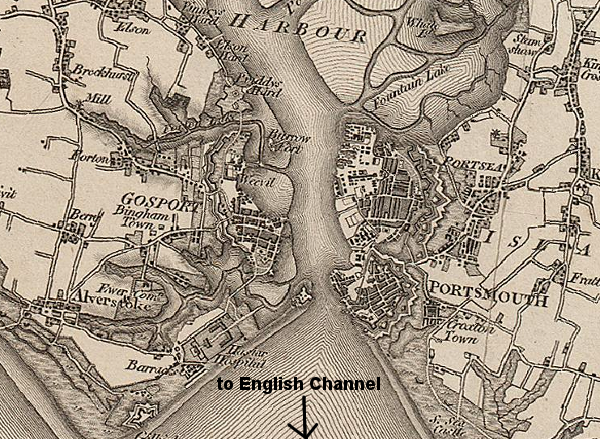
in England, Gosport and Portsmouth are separated by the entrance to the harbor
Source: GB Historical GIS / University of Portsmouth, History of Gosport in Hampshire, A Vision of Britain through Time
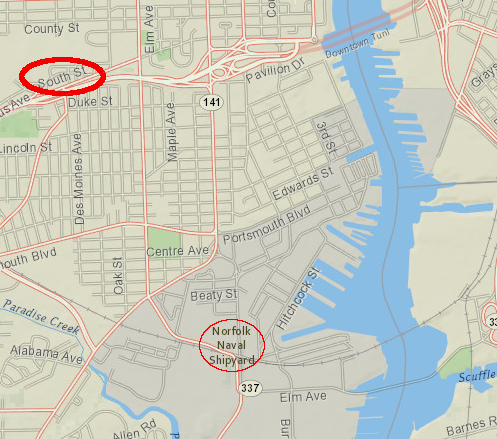
in Virginia, Gosport and Portsmouth were separated by Crab Creek (now underneath I-264, next to South Street)
Source: ESRI, ArcGIS Online
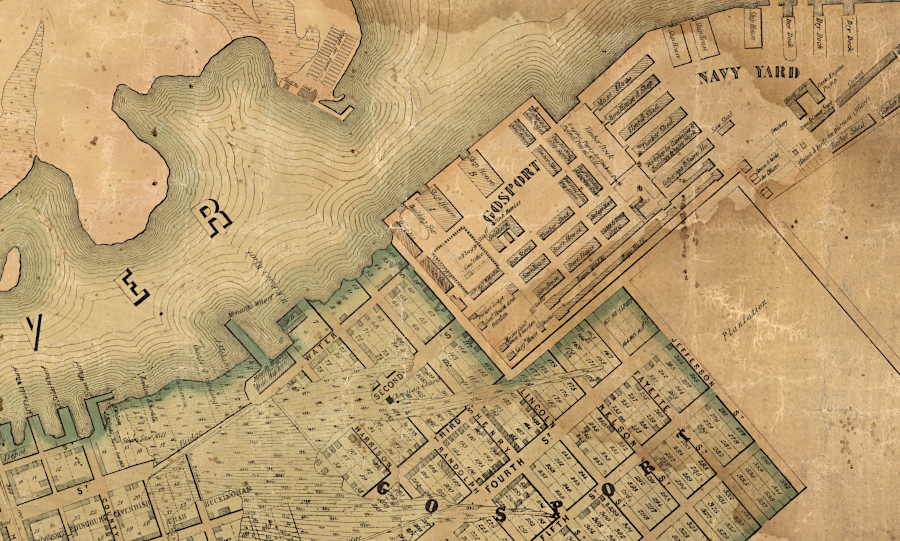
the Navy Yard was in Gosport, separated from Portsmouth by Crab Creek
Source: Library of Congress, Plan of Princess Ann and Norfolk counties (178_?)
Sprowle was a Scottish immigrant with strong business connections based in England. He chose to stay loyal to the British crown during the American Revolution. After Governor Dunmore fled Williamsburg and the small British fleet then sailed south from the York River to the Elizabeth River, the shipyard and nearby town of Portsmouth were used as the land base for the royal forces. Expeditions from the shipyard and town as well gathered food, captured military supplies, and attacked the Virginia militia in Princess Anne, Norfolk, and Nansemond counties.
Sprowle sought protection on a ship with Lord Dunmore. On January 4, 1776, the Virginia militia occupied Portsmouth and burned his buildings at the Gosport Yard. When the British fleet sailed from Hampton Roads to Gwynn's Island in May 1776, Sprowle was on a ship. He apparently died from smallpox on May 29, 1776 and was buried on Gwynn's Island, before Virginia forces brought cannon to the Gloucester County shoreline and the British had to sail away.
Some of Sprowle's enslaved workers survived despite the smallpox epidemic. At least three were still with the British in 1783, and were evacuated when they left New York City at the end of the American Revolution.
In 1779, a British fleet under Commodore George Collier, with 1,800 army troops led by General Edward Mathew, arrived in the Chesapeake Bay to capture/destroy supplies and inflict damage upon the rebels outside of New York/New England. The heavily-outnumbered Virginians were surprised and abandoned their fortification at Fort Nelson, rather than fight.
The Virginians had restablished operations at the Gosport Yard. The British captured or destroyed 137 ships at Hampton Roads, and destroyed what they described as "a very capital marine yard for building ships" at Gosport. Admiral Collier objevted to the destruction of the shipyard. He viewed it as an asset and preferred to occupy Portsmouth, but Mathews was leading a search-and-destroy mission. Collier noted:4
The destruction in 1779 was the second time the shipyard was burned by an invading enemy, assuming the first time was in 1776 by the "invading" Virginia militia as Sprowle and the British fled. The shipyard facilities were burned two more times, but in 1861 and again in 1862 the occupants did the damage.
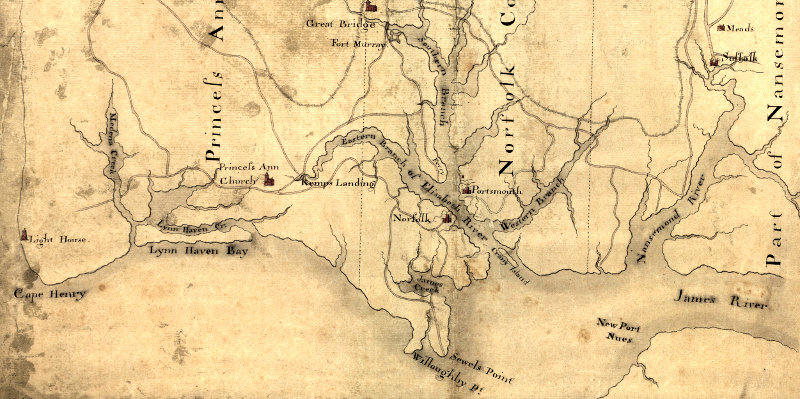
Elizabeth River in Revolutionary War
(note map orientation - south is towards top of map, and Cape Henry is located east of the Elizabeth River)
Source: Library of Congress, Part of the Province of Virginia
Andrew Sprowle's lands were seized by Virginia during the war because he was a loyalist. Some of his properties were surveyed and sold, while the state took ownership of the Gosport Yard. That makes Norfolk Naval Shipyard, according to the US Navy, "the oldest naval shipyard in the United States." The US Navy itself was not established until 1798, and the Washington Navy Yard was started a year later.3
Portsmouth expanded its boundaries and annexed Gosport in 1784. The shipyard has been included within the municipal boundaries of the City of Portsmouth ever since, but the only time "Portsmouth" was included within its many different names was between 1929-1945.
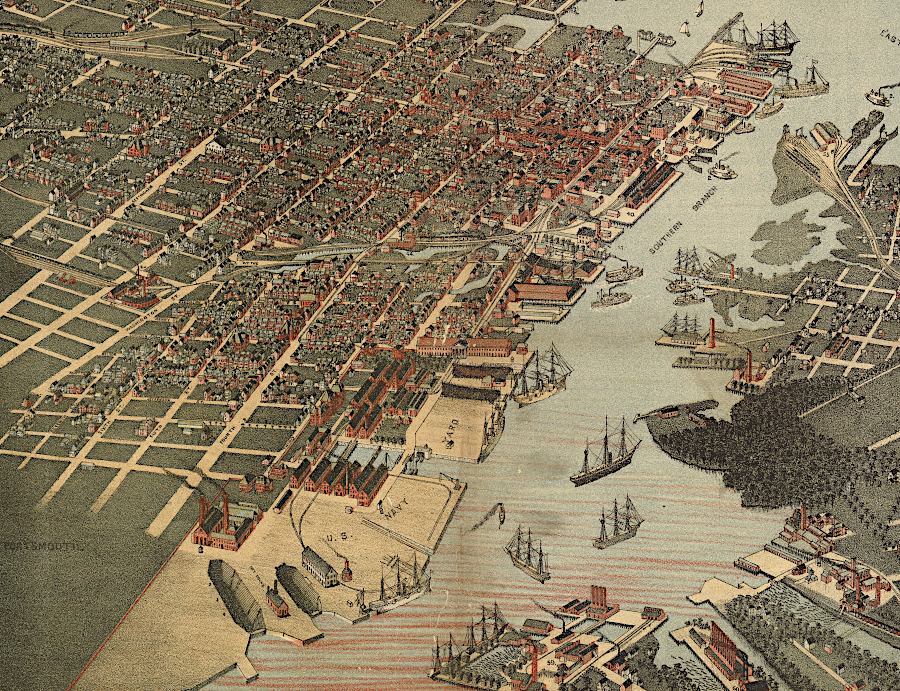
the Gosport Navy Shipyard was constructed on the western side of the Southern Branch of the Elizabeth River, in what became the city of Portsmouth
Source: Library of Congress, Bird's eye view of Norfolk, Portsmouth and Berkley, Norfolk Co., Va. (1891)
In 1794, the US Government leased the Gosport Yard from Virginia and started to build the 36-gun frigate USS Chesapeake. It was one of the first six warships authorized by the US Congress to protect American commercial shipping after Barbary pirates in the Mediterranean demonstrated American military weakness.
On June 15, 1801, the Federal government purchased the 16-acre shipyard, after which it was known as the Gosport Navy Yard. After multiple expansion, the current facility includes 819 acres of land.5
Construction of the USS Chesapeake at the Gosport Navy Yard was interrupted by a temporary outbreak of peace, but the warship finally was completed and commissioned in 1800. In 1807, the USS Chesapeake sailed into the Atlantic Ocean on patrol duty and was quickly challenged by the British warship HMS Leopard. The British warship was stationed off Cape Henry, waiting to intercept two French ships which were getting repaired at the Gosport Navy Shipyard.
The United States was neutral in the war between France and Great Britain; merchants in the Hampton Roads area provided supplies and assistance to ships from both countries. Despite the declaration of neutrality, the British Navy was aggressively seizing ("impressing") sailors from American ships in order to have enough personnel to sail the British warships.
The HMS Leopard demanded the USS Chesapeake surrender four seamen that the British claimed were deserters. The American captain refused to allow the British to impress those seamen. In response, the HMS Leopard fired its cannon at the USS Chesapeake. The American warship was unprepared to fight and quickly surrendered, and that incident helped start the War of 1812.6
In 1813, after the US Congress declared war on England, the British tried to capture the Gosport Navy Yard. The Americans had fortified Craney Island at the mouth of the Elizabeth River. The successful defense of the Craney Island fort against a British amphibious attack kept the British Navy from repeating its 1779 destruction of the shipyard; it survived the war intact.
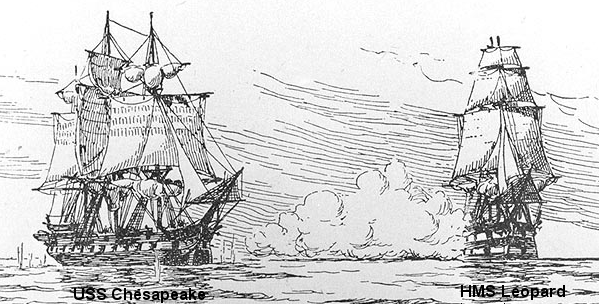
the British assault on the USS Chesapeake (built at Gosport Navy Yard) led to an American embargo on trade with England, and ultimately the War of 1812
Source: US Navy Naval Historical Center, Action between USS Chesapeake and HMS Leopard, 22 June 1807
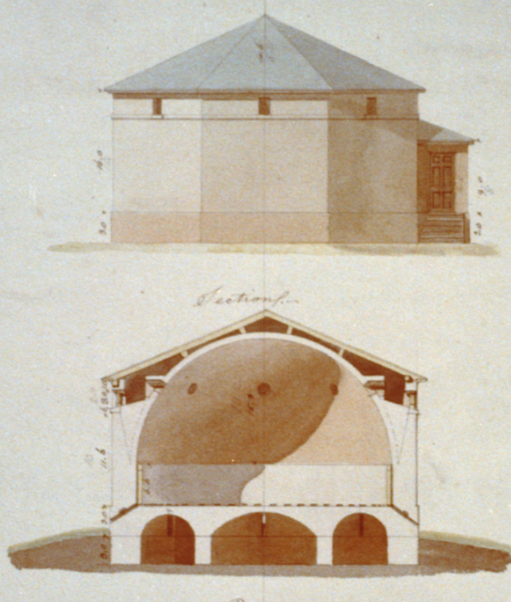
Benjamin Latrobe designed a secure facility ("magazine") to store gunpowder at the Gosport Navy Shipyard
Source: Library of Congress, Powder magazine for the Navy Department, Gosport Navy Yard, Portsmouth, Virginia (1809)
In 1834, the Gosport Navy Yard completed one of the first two drydocks constructed in the United States - matching another "Drydock #1" at Charlestown, Massachusetts.
Because rock is scarce on the Coastal Plain of Virginia, the granite for the drydock was imported from Quincy, Massachusetts. The stones were cut to desired shapes in Virginia, and 75% of the work force consisted of enslaved men hired from their masters. The masters were paid $0.72/day per worker.
The other 25% of "hammers" shaping the stones to fit were white, and they were paid between $1.50 and $2 per day. The white stonemasons objected to the competition, but the Federal government continued to hire enslaved men. The slave labor was more cost-effective and those workers complained less.
The ability to repair as well as construct large warships demonstrated the increasing military capacity of the United States, and President Andrew Jackson came to the shipyard for the opening ceremony.
The Gosport Navy Yard put the USS Delaware into drydock a week before the Massachusetts yard serviced its first vessel, so the oldest continuously operating dry dock in the country is located in Virginia. The drydock eliminated the traditional repair technique of pulling a vessel onto one side ("careening") in order to access the hull that is normally underwater. The cost to build a drydock was substantial, but in the long term cost-effective. Use of the drydock minimized the stress-based damages that could occur during careening and made repairs faster and more efficient.7
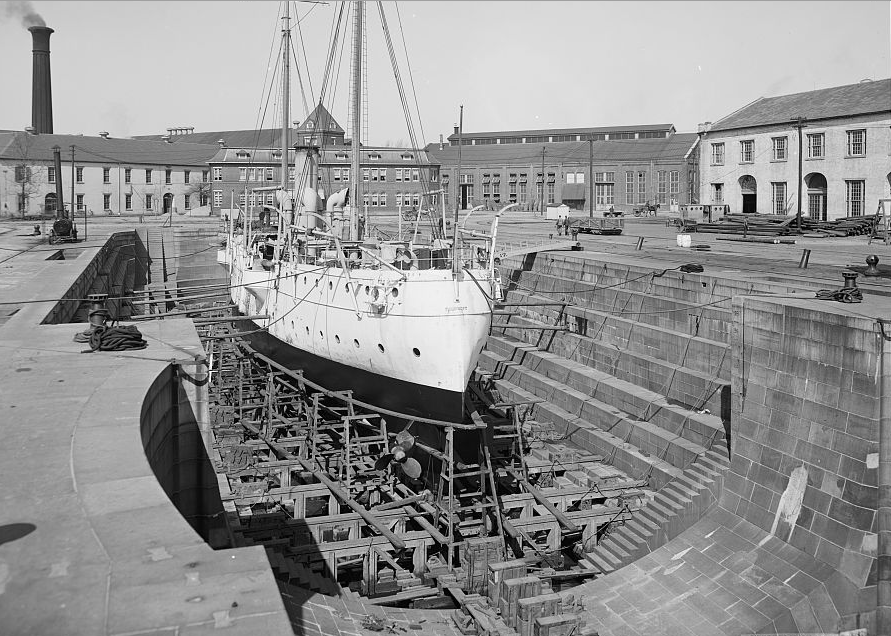
since 1834, the drydock at Gosport (built from Massachusetts granite) has been used to repair vessels
Source: Library of Congress, Stone dry dock, Norfolk Navy Yard, Va.
The Gosport Navy Yard was a key installation of the US Navy prior to the Civil War. Commodore Perry steamed from there in 1851 in his flagship of the Black Fleet. Perry crossed the Pacific Ocean and used warships from Virginia to force Japan to open its ports to foreign trade.8
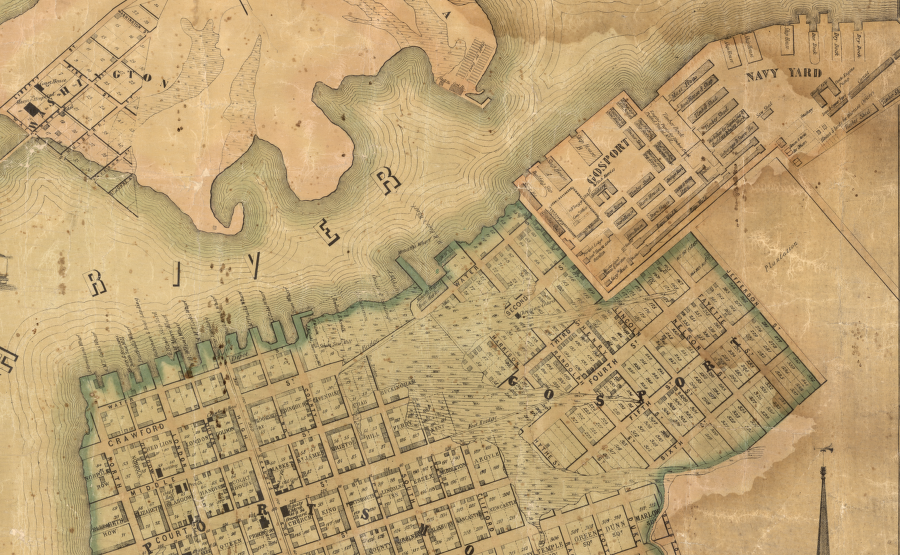
Gosport Navy Yard and Portsmouth in 1851 (note map orientation - south is towards top of map)
Source: Library of Congress, Map of the city of Norfolk and the town of Portsmouth

entrance to Gosport Navy Yard in 1851
Source: Library of Congress, Map of the city of Norfolk and the town of Portsmouth
At the start of the Civil War, Confederates fooled Federal forces into evacuating Gosport on April 20, 1861 without a fight. Thousands of Confederate troops assembled at Portsmouth, arriving on rail cars that could be seen by lookouts on the USS Delaware. What the lookouts did not see was that many of those arriving troops had also left on the same trains headed back towards Petersburg, hidden from sight; the total number of Confederate troops was far smaller than the Union officers at the shipyard estimated.
After successfully intimidating the Union forces at Gosport, local Confederate leaders agreed to leave the Elizabeth River unblocked for evacuation. In exchange, the Union commander at Gosport agreed not to bombard the cities of Portsmouth or Norfolk. However, other Union officials were unwilling to give an intact shipyard and the 11 warships docked there to the Virginia rebels.
The US Navy, which was occupying the shipyard, destroyed its facilities, equipment, and ships before abandoning the site. The USS Pawnee sailed up the Elizabeth River and opened fire on the Gosport Navy Yard. US Marines from the USS Pawnee helped burn and scuttle the warships, including the USS Merrimack. The Union forces were unable to blow up the stone drydock before leaving. Many cannon were left behind as well.9
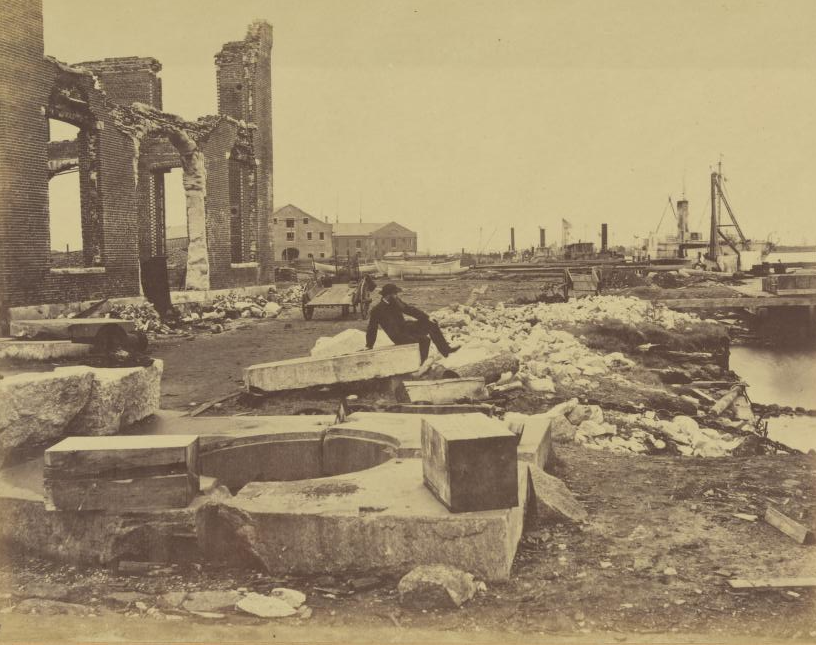
Norfolk Naval Yard in December, 1864 after destruction by Union and then Confederate forces in 1861-1862
Source: Alexander Gardner, Gardner's Photographic Sketch Book of the War
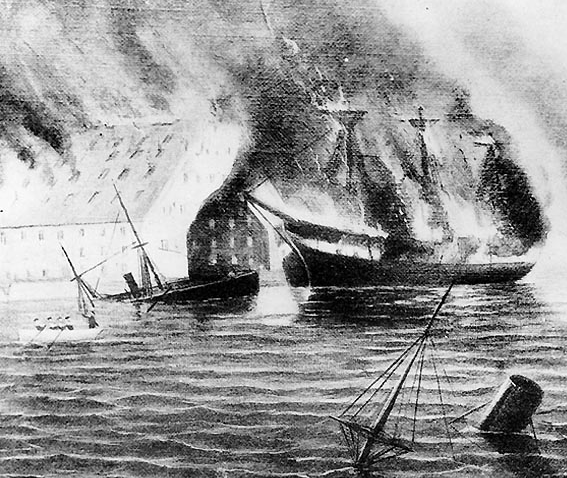
Federal forces burned the USS Merrimack along with the shipyard in 1861
Source: US Navy National History and Heritage Command, Online Library of Selected Images (Photo #:NH 58880)
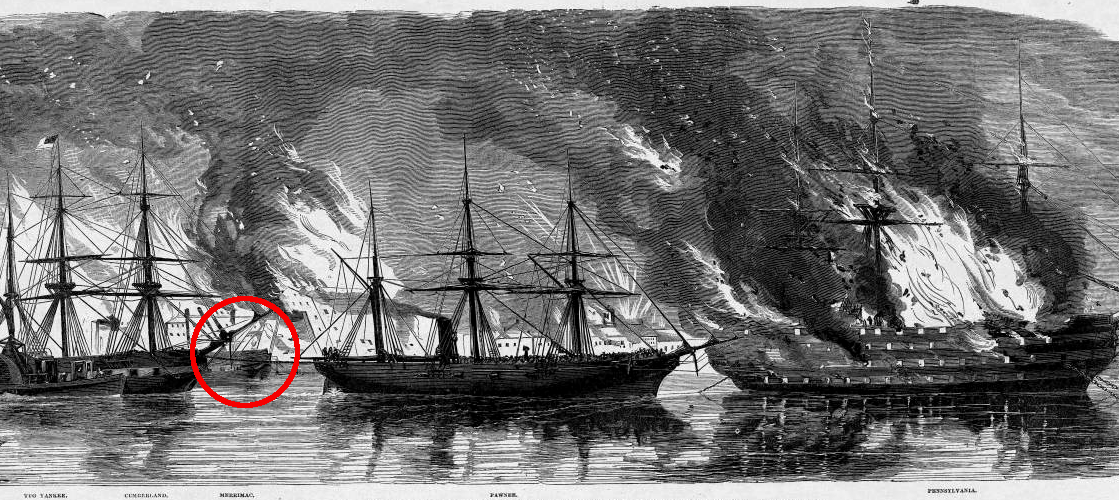
the USS Merrimack was just one of the 11 warships burned by the Federal Navy in 1861
Source: Harpers Weekly, Destruction of the United States Ships at the Norfolk Navy-Yard, By Order of the Government (May 11, 1861)
The Virginia militia controlled the shipyard only briefly before transferring it to the Confederate national government. The Confederates were able to raise the USS Merrimack. They used Dry Dock #1 to convert it into the ironclad CSS Virginia.
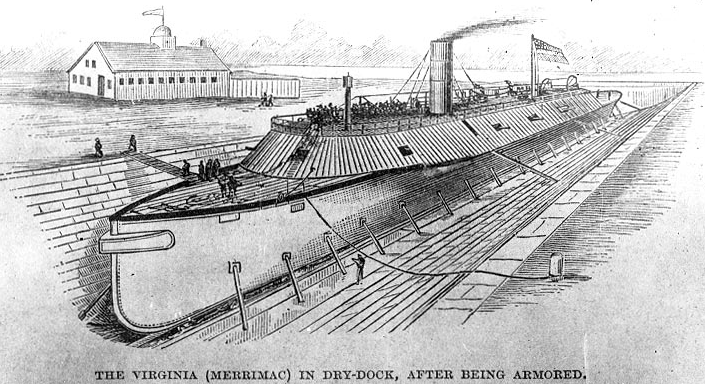
Drydock #1 at Gosport Navy Yard, completed in 1834, was used to convert the USS Merrimac into the CSS Virginia
Source: US Navy National History and Heritage Command, Online Library of Selected Images (Photo#:NH 314)
In 1862, the Confederate warships in the Elizabeth River blocked the Union navy from using the James River to support General McClellan's march up the Peninsula. McClellan established his first supply base beyond Fort Monroe at White House on the Pamunkey River, a tributary of the York River out of reach of the Confederate warships.
At Hampton Roads, the CSS Virginia attacked the Union fleet and had one day of uncontested control of the water on March 8, 1861. The Federal ironclad USS Monitor arrived and fought the CSS Virginia to a standstill the following day. After the "Battle of the Ironclads," the CSS Virginia retreated up the Elizabeth River and never fought again. It was unable to escape out of the Elizabeth River and steam up to Richmond because the shipping channel in the James River was too shallow for the heavy iron-coated ship.

CSS Virginia
Source: US Navy National History and Heritage Command, Online Library of Selected Images (Photo#:NH 57830)
When the Union finally seized Norfolk, the Confederates abandoned Portsmouth. In their retreat, they burned the Gosport Navy Yard again. The Confederate ironclad CSS Virginia in the Elizabeth River was blown up next to Craney Island early in the morning of May 11, 1862.10
After the Confederates evacuated the shipyard in 1862 and the Union re-occupied it, the name Gosport was finally dropped. The Gosport Navy Yard was retitled U.S. Navy Yard, Norfolk. That name was revised in 1929 to Norfolk Navy Yard, Portsmouth, then to Norfolk Naval Shipyard in 1945. Though located in Portsmouth, the yard was named after the larger city of Norfolk across the Elizabeth River. That minimized potential confusion with Portsmouth Naval Shipyard in Portsmouth, New Hampshire.11
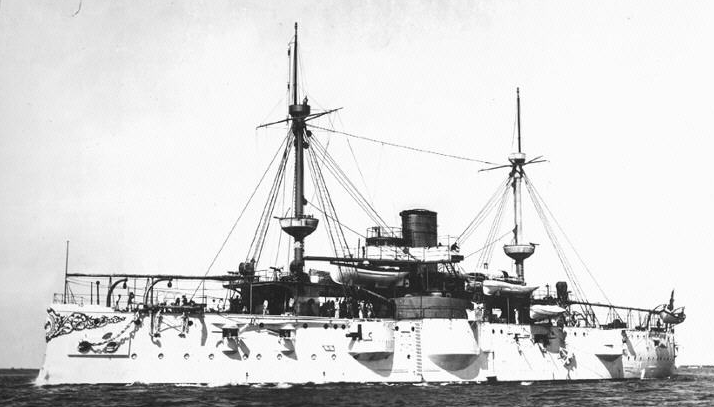
the USS Texas was built at the U.S. Navy Yard, Norfolk and launched in 1892
Source: US Navy Naval Historical Center, USS Texas (1895-1911), later renamed San Marcos
The US Navy's first battleship, the USS Texas, was built from scratch at the U.S. Navy Yard, Norfolk and launched in 1892. The USS Maine was built at nearly the same time at the Brooklyn Navy Yard. In 1898, after the USS Maine blew up in the harbor at Havana in an event that triggered the Spanish-American War, the USS Texas helped destroy the Spanish fleet in Cuba.
The USS Texas was left behind in Hampton Roads when the Great White Fleet of battleships sailed from Hampton Roads in 1907. The Great White Fleet demonstrated that the United States possessed a blue-water navy capable of projecting military power around the world. It also showed that bigger "dreadnought" battleships would be the design of the future; the USS Texas was outdated.
In 1911, the USS Texas was renamed the USS San Marcos, then used for gunnery exercises and sunk in the Chesapeake Bay over six miles from Tangier Island. It reportedly damaged seven ships as a sunken wreck, doing more damage from underwater than it ever did when a floating warship. In 1959, US Navy divers blasted out a trench underwater and the wreck rolled over, finally ending up 20 feet below the surface.12
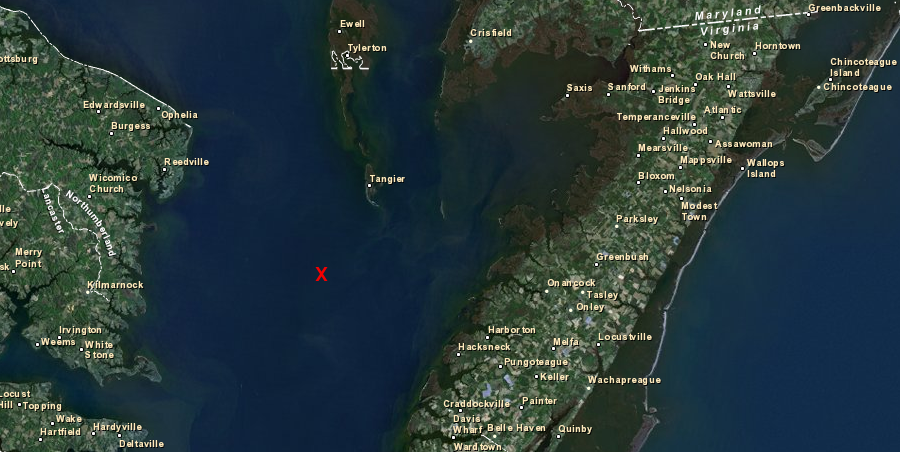
the USS Texas (renamed the USS San Marcos) was sunk off Tangier Island and used for target practice until 1959
Source: ESRI, ArcGIS Online

the former USS Texas, built at Norfolk Naval Yard, is now a navigation hazard near Tangier Island marked on nautical charts
Source: National Oceanic and Atmospheric Administration (NOAA), Chesapeake Bay Pocomoke and Tangier Sounds (2011)
The first aircraft carrier, USS Langley, was commissioned at the U.S. Navy Yard, Norfolk on March 20, 1922. The coal-carrying USS Jupiter, was decommissioned in 1020 and, after two years, converted into the USS Langley to launch airplanes. The innovative approach matched the way the shipyard had converted the frame of the USS Merrimack into the CSS Virginia 60 years earlier. The USS Langley was sunk during World War II and now lies at the bottom of the South Pacific near Indonesia.13
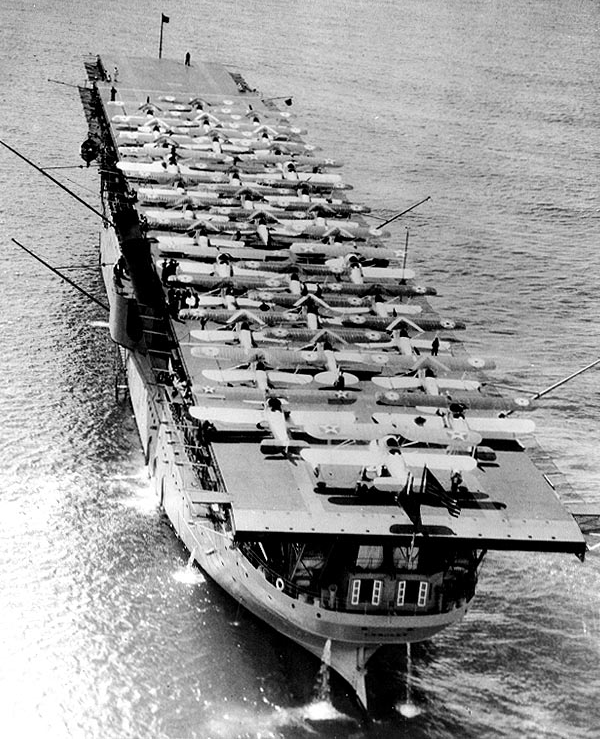
the USS Langley, first aircraft carrier built by the United States, was constructed at the Norfolk Naval Shipyard after World War I
Source: US Navy Naval Historical Center, USS Langley (CV-1)
The Washington Naval Treaty of 1922 limited the number of battleships which nations could operate. The shipyard stopped construction of the USS North Carolina and the battleship was scrapped. The shipyard built destroyers instead; the treaty had set no limit on that class of ships. The separate, private Newport News Shipyard became the site for constructing aircraft carriers; the Norfolk Naval Shipyard has never built a nuclear-fueled ship.
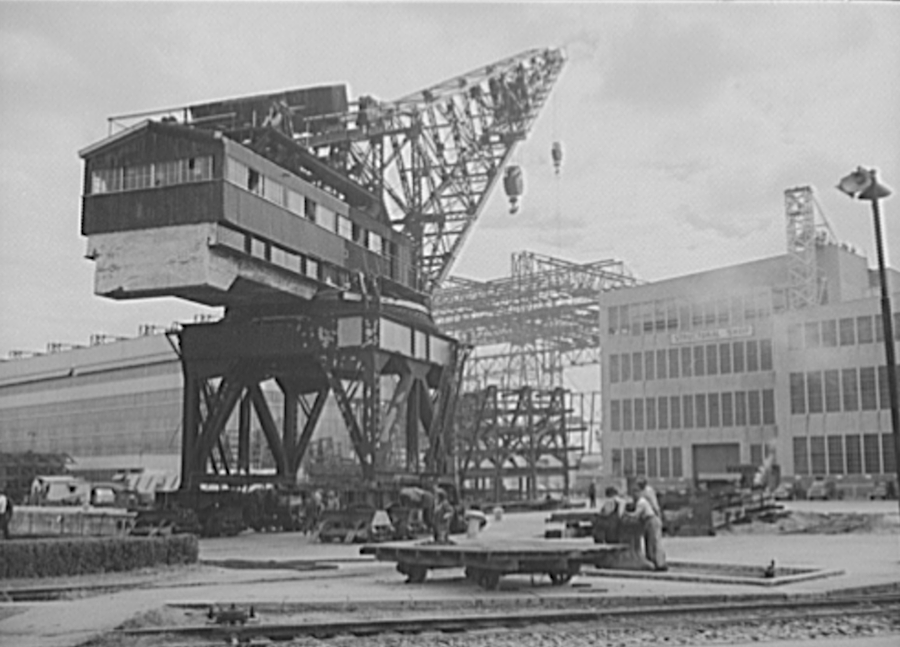
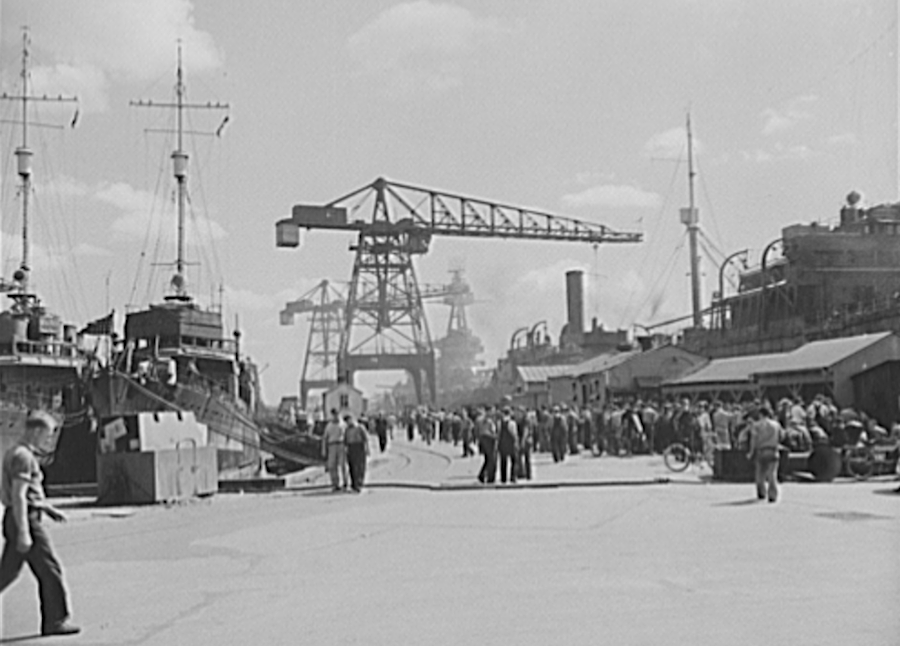
huge cranes were used to transport heavy parts when constructing ships in 1941
Source: Library of Congress, Shipbuilding (Norfolk Navy Yard) and It's lunch time, and thousands of workers are taking their thirty minutes of recreation
After World War II, the Norfolk Naval Shipyard focused on repair and modernization, including repair of conventional aircraft carriers. Norfolk Naval Shipyard was authorized to overhaul nuclear ships in 1963. In 2013, Virginia had more shipbuilding jobs than any other state.14
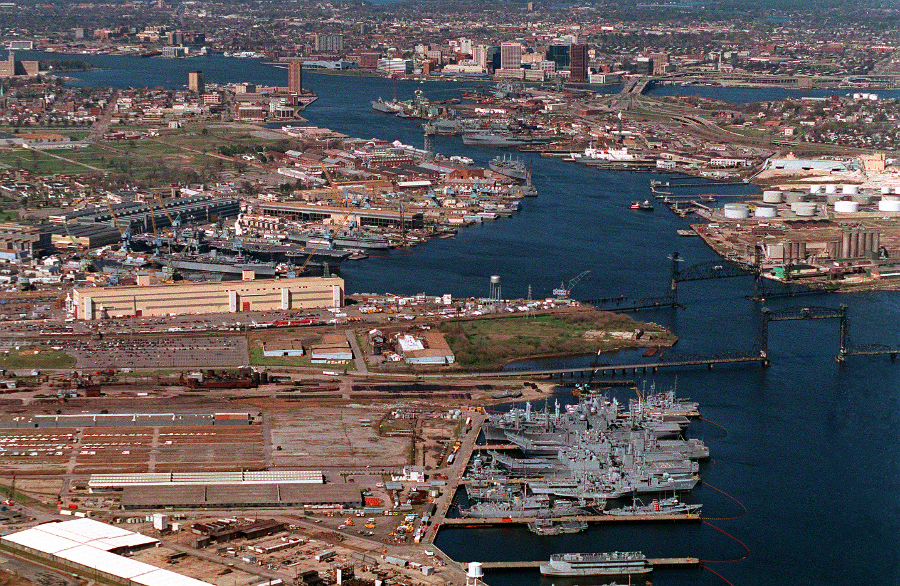
looking north in 1995 along the Southern Branch of the Elizabeth River (Norfolk Naval Shipyard on left, downtown Norfolk in distance)
Source: National Archives, An aerial view of the Norfolk Naval Shipyard located on the Elizabeth River. At the bottom right is the South Gate Annex where ships of the mothball fleet are stored. At left center is the main shipyard. Further back on the righthand side of the river is the Norfolk Shipbuilding & Drydock Company (NORSHIPCO). The city of Norfolk is in the background, 03/25/1995
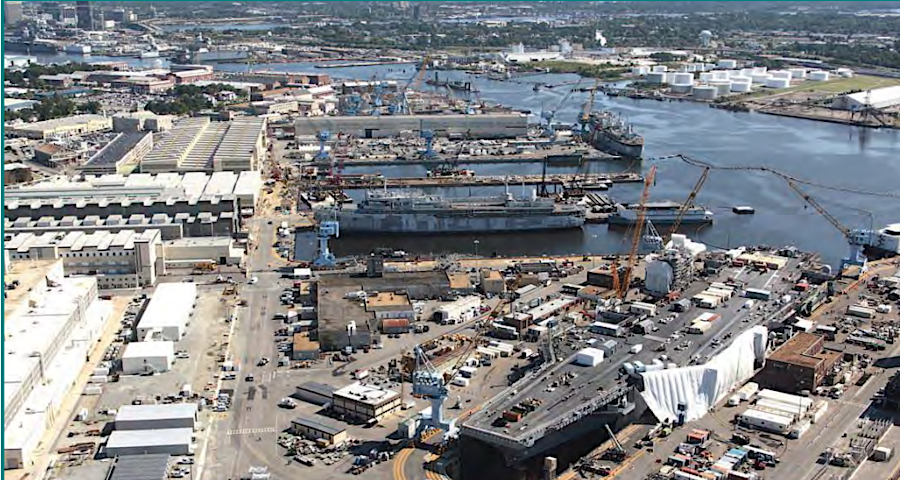
the Norfolk Navy Shipyard repairs the biggest ships in the fleet
Source: Department of the Navy, Environmental Assessment For Implementation Of Energy Conservation Measures At Norfolk Naval Shipyard, Portsmouth, Virginia
The US Navy has owned 13 different shipyards in its history; the Defense Department maintains four public shipyards now. In addition to Norfolk Naval Shipyard in Portsmouth, Virginia, there is Portsmouth Naval Shipyard in Kittery, Maine, Puget Sound Naval Shipyard and Intermediate Maintenance Facility in Bremerton, Washington, and the Pearl Harbor Naval Shipyard and Intermediate Maintenance Facility in Hawaii.
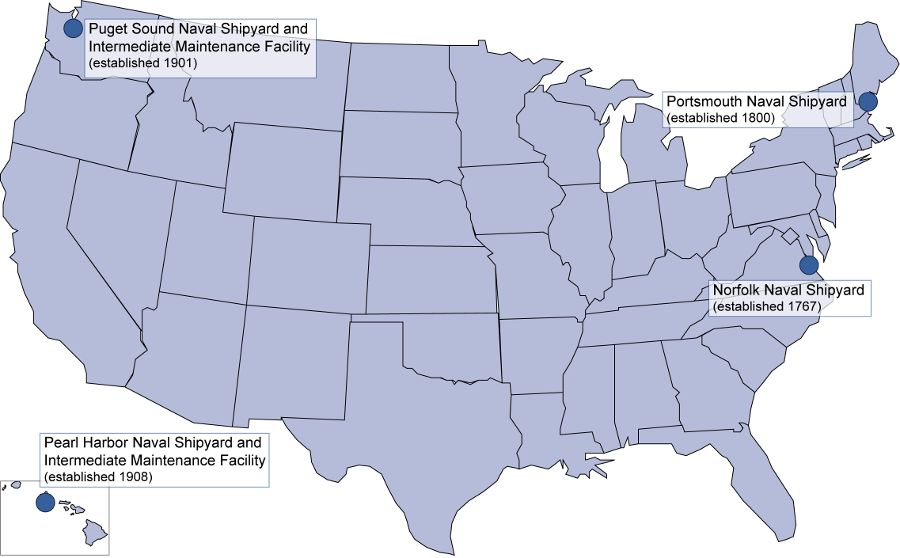
there are two US Navy shipyards located on the Atlantic Ocean, and two on the Pacific Ocean
Source: Government Accountability Office (GAO), Naval Shipyards: Actions Needed to Improve Poor Conditions that Affect Operations (Figure 1)
In addition, some repairs are done at the Mid Atlantic Regional Maintenance Center at Little Creek. The second-oldest vessel in the US Navy, after the USS Constitution, is the drydock USS Dynamic. It went into service in 1944, and was refurbished to start another 75 years of operations in 2019. The drydock is used to repair US Navy, Army, and Coast Guard boats that operate in shallow waters close to shore such as landing craft, utility boats, and patrol vessels.
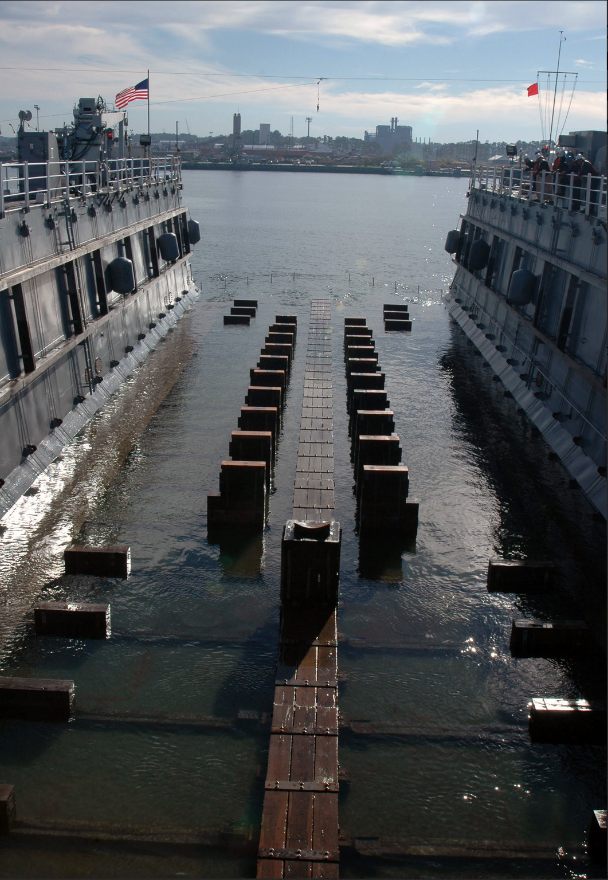
auxiliary drydocks, such as the USS Dynamic at Little Creek, are located outside of the US Navy shipyards
Source: PICRYL.com - U.S. National Archives, U.S. Navy Auxiliary Floating Dry Dock DYNAMIC (AFDL 6)
The Department of Defense maintenance centers and larger shipyards do not deal with commercial ships. Commercial shipyards are used to maintain and repair 95% of the US Navy surface vessels. The US Navy also contracts out the dismantlement of nuclear-powered aircraft carriers that have reached the end of their 50-year life. The US Navy decided in 2023 that dismantlement of the USS Enterprise (CVN-65), stored temporarily at the Newport News Shipyard, would be done at a commercial shipyard. If that task was assigned to the Puget Sound Naval Shipyard and Intermediate Maintenance Facility, it might not be completed until 2040.
Out of the 276 ships operated by the US Navy in 2017, the four US Navy shipyards concentrated on maintaining 10 aircraft carriers and 70 submarines:15
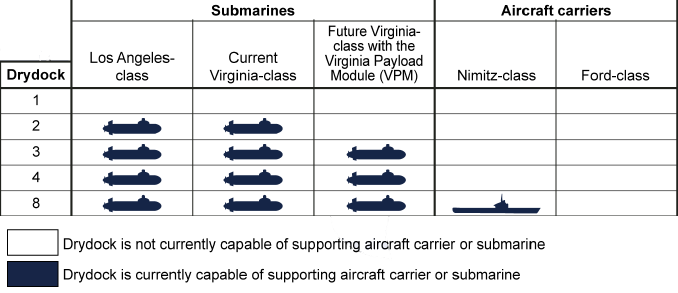


four of the five drydocks at the Norfolk Navy Shipyard can service submarines and aircraft carriers
Source: Government Accountability Office (GAO), Naval Shipyards: Actions Needed to Improve Poor Conditions that Affect Operations (Figure 1); Norfolk Naval Shipyard, Combined Heat and Power Plant and Energy Conservation Measures Briefing (July 1, 2020)
Puget Sound Naval Shipyard and Intermediate Maintenance Facility is the only shipyard with the capability to remove and dispose of nuclear reactors. The Portsmouth Naval Shipyard in Maine deals only with repair of nuclear submarines, while the others handle a wide range of ships. The "Portsmouth Naval Shipyard" is not in either Portsmouth, Virginia or Portsmouth, New Hampshire. It is located across the state line in Maine.
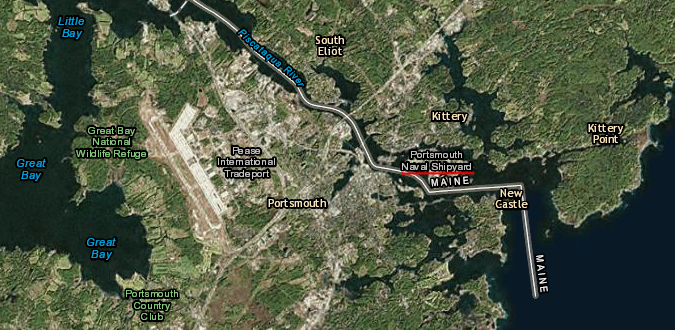
the Portsmouth Naval Shipyard is in Kittery, Maine - not in Portsmouth, Virginia or Portsmouth, New Hampshire
Source: ESRI, ArcGIS Online
Norfolk Naval Shipyard is the only public shipyard on the East Coast able to repair aircraft carriers in drydock. It is:16
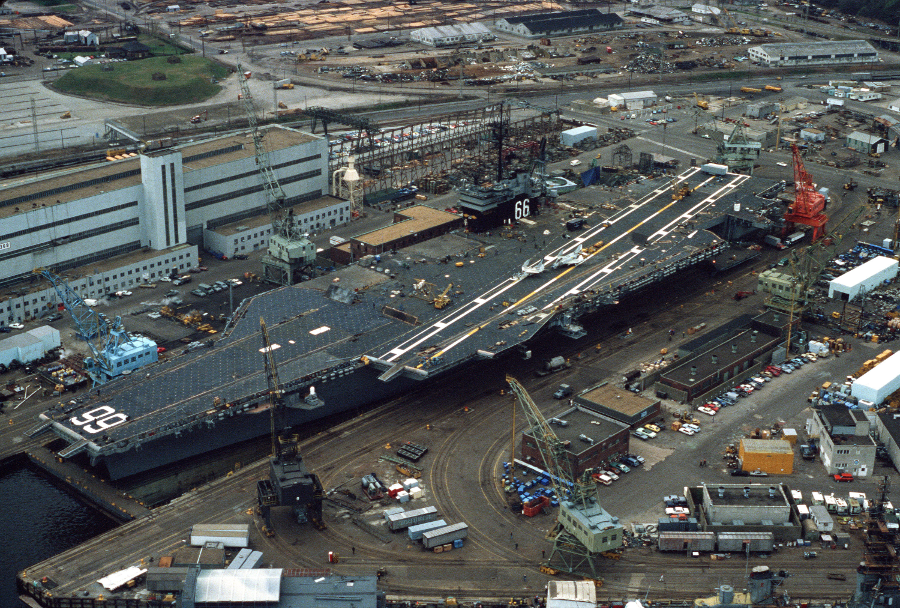
the drydock at the Norfolk Naval Shipyard is large enough for aircraft carriers to be repaired and serviced
Source: National Archives, An aerial view of the aircraft carrier USS AMERICA (CV 66) in dry dock at the Norfolk Naval Shipyard, 06/01/1982
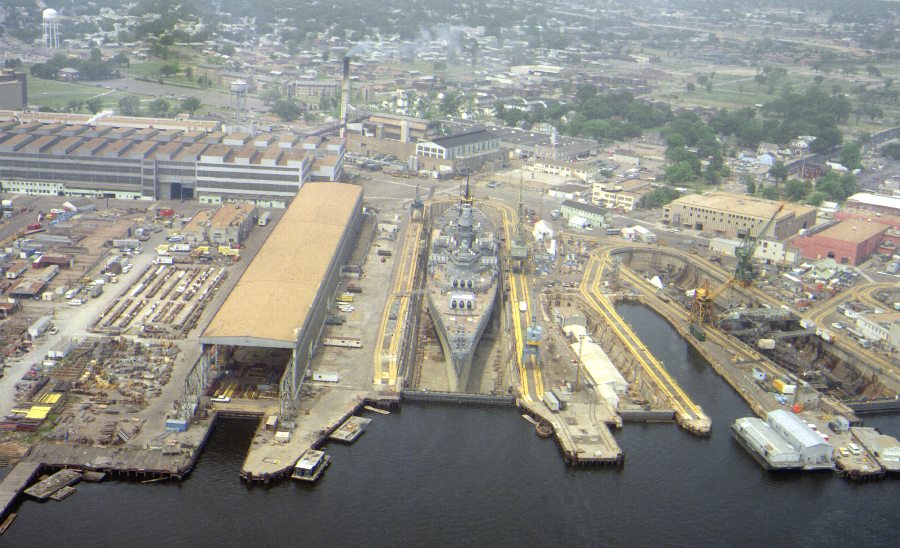
the Norfolk Naval Shipyard repaired battleships throughout the 20th Century before they were all retired
Source: National Archives, An aerial view of the battleship USS IOWA (BB-61) in dry dock No. 4 at the Norfolk Naval Shipyard, 05/11/1985
The industrial activities at the shipyard produced hazardous wastes, including abrasive blast grit with paint residues, heavy metals, solvents, oils, and polychlorinated biphenyls (PCBs). Before the facility began to use an industrial waste treatment plant in 1979, wastes were discharged to Paradise Creek and the Southern Branch of the Elizabeth River.
The site was added to the Comprehensive Environmental Response, Compensation and Liability Act "Superfund" list in 1999. The adjacent Atlantic Wood Industries Inc., which is a separate Superfund site, also deposited creosote into wetlands and the adjacent streams. Atlantic Wood Industries was designated as a Superfund site in 1990.
At the shipyard, contaminated earth was excavated and transported to secure waste disposal locations. The primary solution for the Superfund cleanup at Atlantic Wood Industries, just south (upstream) of the shipyard, was to build a new wall along the river and isolate the contaminants. Encapsulating the material on site was less expensive, but controversial. An official at the Virginia Marine Resources Commission said:17
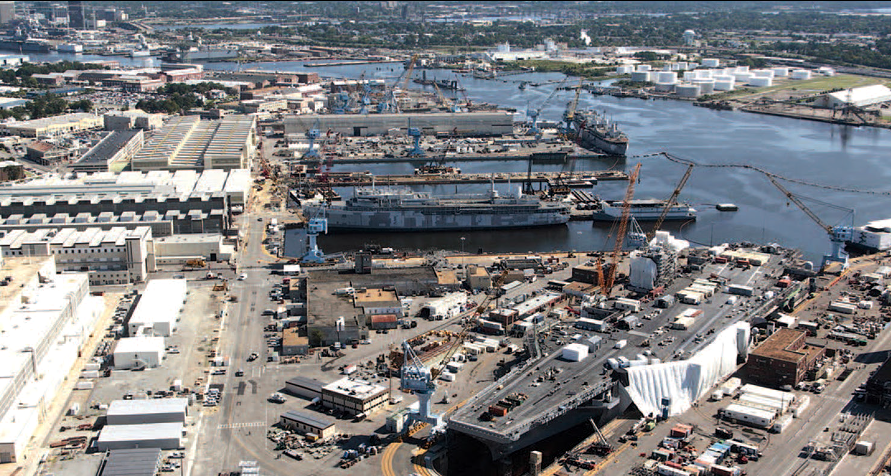
Norfolk Navy Shipyard (in Portsmouth, Virginia) is the Navy's oldest shipyard
Source: Government Accountability Office (GAO), Naval Shipyards: Actions Needed to Improve Poor Conditions that Affect Operations (Figure 15)
The Norfolk Naval Shipyard is the nation's oldest military shipyard. It was built to construct and service wooden vessels powered by wind, and has been destroyed and rebuilt three times. Over the last two-and-a-half centuries, the US Congress has appropriated funds to modernize it, but the Government Accountability Office noted in 2017 that the facility was not capable of performing the planned workload.
The report noted that one drydock at Norfolk required pumping extra water into the drydock (superflooding) in order to accommodate today's larger ships. Raising the water in the drydock higher than normal tide level could flood electrical and service galleries with corrosive saltwater. To get submarines into Drydock 1 required buoyancy assistance equipment, and that work-around would not be possible for servicing future submarine classes.
Four of the five drydocks are exposed to flooding from extreme high tides and hurricanes, and three are in the 10-year flood plain. Tidal-related storm damage is frequent, and there is an average of one major flood event annually now.
Old equipment failed tests to ensure reliable repairs:18
In 2018, the US Navy initiated the Shipyard Infrastructure Optimization Program (SIOP). That 20-year plan anticipated a $21 billion investment to upgrade facilities a Norfolk Naval Shipyard in Virginia, Pearl Harbor Naval Shipyard and Intermediate Maintenance Facility in Hawaii, Portsmouth Naval Shipyard in Maine, and Puget Sound Naval Shipyard and Intermediate Maintenance Facility in Washington.
Enhancements included digitizing the facilities to create models, then redesigning the inefficient flow of repairs through each yard:19
The backlog in repairs kept warships from being deployed. Rep. Rob Wittman, co-chair of the Shipbuilding Caucus even though his 1st District did not include the Norfolk Naval Shipyard or Newport News Shipbuilding, said in 2020:20
In 2018, the Norfolk Naval Shipyard completed a new pier that allowed simultaneous repair and maintenance of two aircraft carriers. A $200 million renovation of Dry Dock 4, to improve the ability to overhaul nuclear-powered submarines, began in 2020. That component had first opened in 1919, as the shipyard was expanded for World War I.
The shipyard also received approval in 2020 from the State Air Pollution Control Board to install two 7MW turbines, fueled by natural gas, to generate electricity and steam. The shipyard had been purchasing steam from the Wheelabrator incinerator, which burned municipal solid waste.21
By the start of 2023, the Shipyard Infrastructure Optimization Program (SIOP) renovation of a dry dock at Portsmouth Naval Shipyard in Kittery, Maine demonstrated a rapid rise in costs. The original estimate was $423 million, but by 2023 it had swelled to $2.2 billion. Estimated cost for drydock work at Pearl Harbor had increased by over 150%.
Cost of steel and other materials had increased dramatically during the COVID-19 pandemic, and initial estimates were poor in part because it was the US Navy's first major dry dock repair project in 40 years. A Government Accountability Office report criticized the US Navy's cost sensitivity, risk, and uncertainty analyses, and the failure to update funding requests based on final design.
By 2024 there were 40 projects underway at the Norfolk Naval Shipyard, at a cost of $500 million. The US Navy upgraded the electrical infrastructure first at its Norfolk facilities to support the USS Gerald Ford and future carriers of that class. When docked, they required three times the electricity compared to the Nimitz-class carriers. The USS George H. W. Bush is scheduled to be the last Nimitz-class carrier to be replaced, in 2069.
The US Navy expects to maintain a fleet of 11 aircraft carriers, with all Atlantic Ocean carriers home-ported in Norfolk. The second Ford-class carrier, the USS John F. Kennedy, could not be stationed at Naval Base Kitsap in Puget Sound until the electrical upgrades were finished at the Puget Sound Naval Shipyard.
Dry Dock 4, built originally in 1919, was being upgraded for overhauls of Ohio-, Virginia- and Columbia-class submarines. changes to Dry Dock 3 were funded in the FY25 budget for overhauls of Los Angeles-class and Virginia-class submarines. Rehabilitation of Dry Dock 8 for the new Ford-class aircraft carriers, bigger than the Nimitz-class ships, was expected to be finished before the USS Ford required maintenance in 2027. The shipyard's program executive officer for industrial infrastructure described the investment in the upgrade in simple terms:22
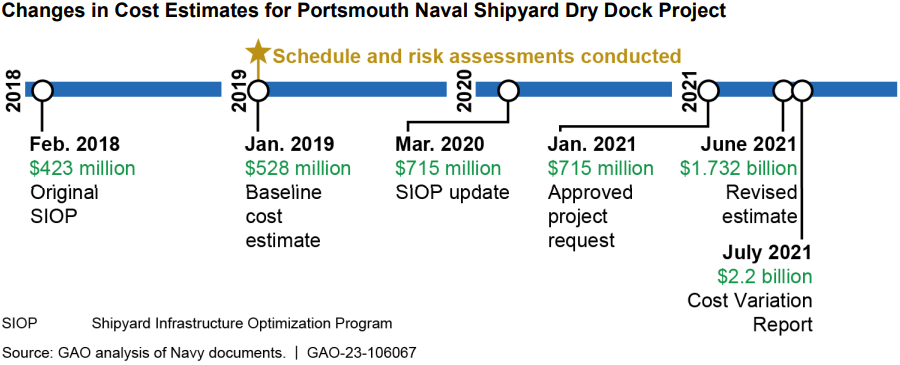
the Navy's original cost estimates for upgrading the dry dock at the Norfolk Navy Shipyard were wildly inaccurate
Source: Government Accountability Office (GAO), Navy Readiness: Actions Needed to Address Cost and Schedule Estimates for Shipyard Improvement (GAO-23-106067)
The Norfolk Naval Shipyard does not repair the oldest commissioned ship in the United States Navy, the USS Constitution. That ship was built at the Charlestown Navy Yard in 1797, two years before the USS Chesapeake was completed at Gosport. In the War of 1812, the USS Constitution gained the name "Old Ironsides" as British cannonballs bounced off its two-foot thick hull of white oak planks.
The ship was retained after 1855 as a training vessel, barracks, and finally a historical museum. It served as a training ship at Portsmouth Naval Shipyard between 1882-1897, when it returned permanently to the Charlestown Navy Yard in Boston. Most of the original oak planks were replaced by routine repairs and then major overhauls, especially in 1927-31 and 1992-96. The US Navy grows a reliable supply of oak trees at Naval Support Activity Crane in Indiana, to ensure there will always be the raw material for future repairs.
The USS Constitution has visited Hampton Roads, but its repairs are done at the dry dock of the Charlestown Navy Yard.23
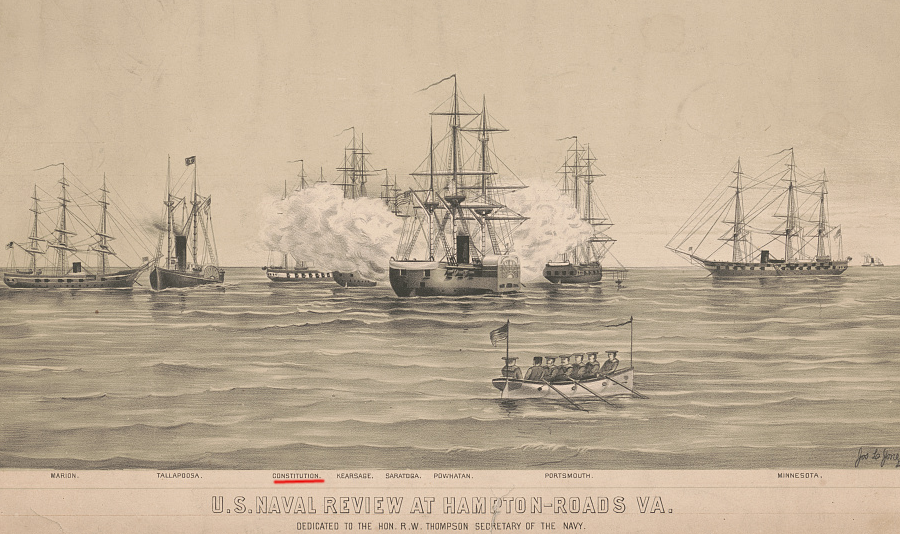
the USS Constitution has visited the Norfolk Navy Shipyard, but is repaired at the dry dock of the Charlestown Navy Yard
Source: Library of Congress, U.S. Naval review at Hampton-Roads VA (1880)
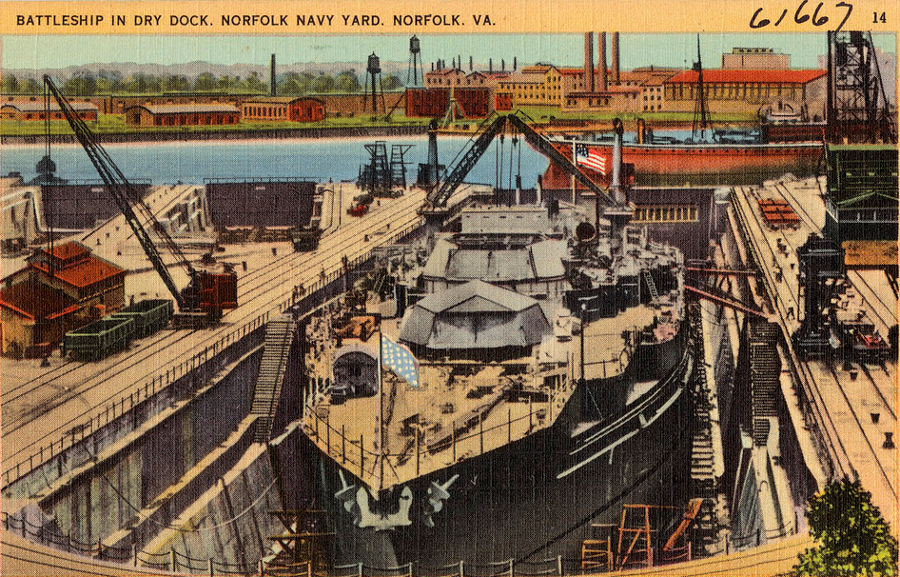
a pre-World War II postcard shows use of the drydock at Norfolk Navy Shipyard
Source: Boston Public Library, Battleship in dry dock, Norfolk Navy Yard, Norfolk, VA
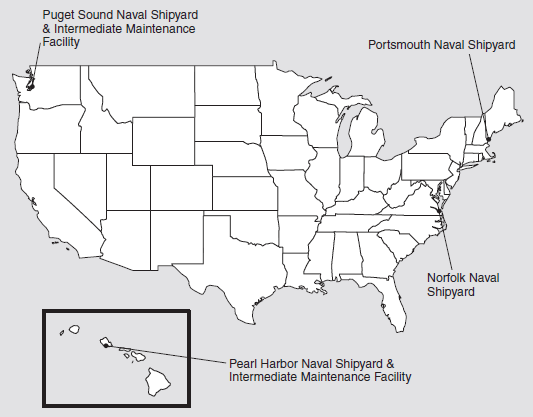
the US Navy maintains four public shipyards (Newport News is a private shipyard)
Source: Government Accountability Office (GAO), Actions Needed to Improve the Navy's Processes for Managing Public Shipyards' Restoration and Modernization Needs
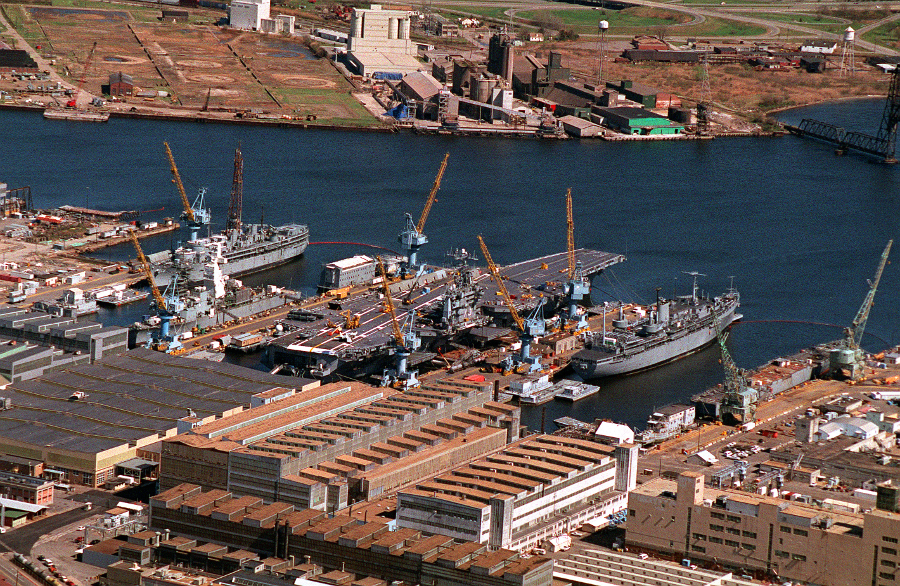
the Norfolk Naval Shipyard repairs/services active warships and also strips down decommissioned vessels
Source: National Archives, An aerial view of the Norfolk Naval Shipyard located on the Elizabeth River. The nuclear-powered aircraft carrier USS GEORGE WASHGINGTON (CVN-73) is in the yard for a post-deployment overhaul. To the right of the GW is the decommissioned submarine tender HUNLEY (AS-31) and further to the right is the stripped down hull of the decommissioned guided missile cruiser VIRGINIA (CGN-38), 03/25/1995
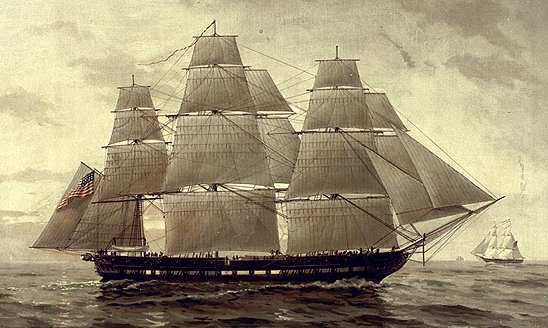
the USS Chesapeake was completed at the Gosport Navy Yard in 1800, patrolled the Mediterranean to counter Barbary pirates, was forced to surrender to HMS Leopold in 1807, and was defeated and captured by the HMS Shannon in 1813
Source: Naval Historical Center, Online Library of Selected Images

since the Civil War, additional drydocks have been constructed at Norfolk Naval Shipyard
Source: Library of Congress, Photocopy of Plan - Norfolk Navy Yard (1866)
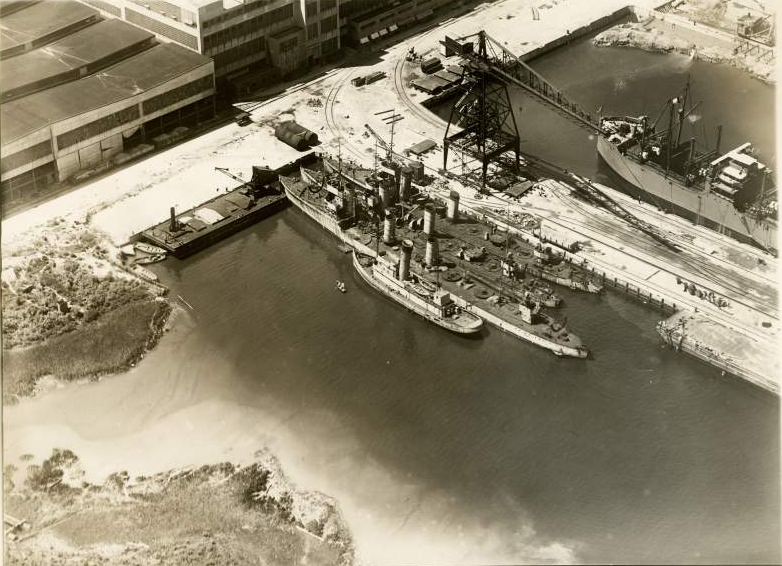
German destroyers seized after World War I were brought to what was called, at that time, the "U.S. Navy Yard, Norfolk"
Source: Smithsonian Institution, Events, 1921, USA, Virginia (VA), US Army Air Service Ship Bombing Trials